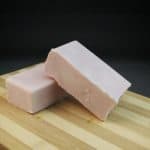Black mold sounds like a toxic, lethal horror show. But how do you know if you have it? Where does it thrive? Does it cause serious health problems? And how do you get rid of it? Learn more about black mold symptoms and more….

What is black mold?
It’s a toxic fungus among us!
That’s at least what the media would have us believe. The truth is that while it can cause serious illness, it’s not the killer many people think it is….
Molds are fungus. So, too, are yeasts and mushrooms.
What do nearly all fungi have in common? What do they love?
The answer is damp, warm, humid places. That’s why when it does flourish, it’s most often in the shower or bathroom.
Fungi produce spores. Think of spores as the offspring of fungus. Spores sound like something bad. And in fact, they can be toxic. ‘Mycotoxins’ is another name for spores.
Before you freak out about mycotoxins, here’s the thing. They only kill you when you’re exposed to a very large amount of them.
But if you have black mold at home, that’s probably no comfort. After all, it’s hard to know how much exposure is too much.
The good news is exposure to black mold is rarely lethal. In fact, if you do have black mold in your house, it might not even be toxic. (And, it might not even be black; more on why in a bit….)
Now, the bad news: if the mold you have is, say, green, it could be toxic.
So how can you identify if the mold you have in your house is toxic?
Pretty much the only way to know for sure is hiring a certified mold inspector.
What Does Black Mold Look Like?
This particular type of fungus isn’t necessarily always very dark. In fact, it can be gray or green.
Stachybotrys chartarum is considered true toxic black mold. One thing it has no resemblance to is the spoilage on bad food in your pantry or fridge. In other words, it’s not fuzzy. Rather, it’s slimy.
You may notice some very dark spots in your shower, tub or bathroom. But that doesn’t mean it’s toxic black mold. In fact, chances are more likely, it’s not.
However, the very potentially-harmful spores thrive in areas that aren’t cleaned very often. And those that are very humid, damp and dark. That’s why fungus flourishes in basements, attics, and crawl spaces.
Keep in mind most often, the only time you’ll need to be concerned about it is if you’re either trying to buy or sell a house.
For real estate inspections, a mold assessment is common. Sometimes, a mold remediation is needed. (However, if you’re planning on buying a house that has toxic black mold, ask yourself if you really love the house that much.)
Anywhere there’s moisture, fungus can find enough organic material from which to feed. Most people associate bathrooms and showers with moldy stains. However, toxic black mold can also be found under floorboards. Same goes for carpeting and even drywall.
And if you do have the harmful spores in your home, over the years, as you inhale more and more of the spores, health problems can arise….

Toxic Black Mold Symptoms
Perhaps the most serious condition you can get from the nasty fungus is scarring in your lungs, known as pulmonary fibrosis. This makes you more vulnerable to developing lung cancer.
However, the most common health problem caused by harmful fungus is allergies. Allergies can make life very unpleasant. But most often, they’re not going to kill you.
In fact, according to WebMD, there’s no direct evidence that links any mold to cancer.
The worst that can probably happen if you inhale pathogenic spores is you’ll develop very bad coughing. You may also have other symptoms that affect the lungs, eyes, nose and throat.
Some people may also develop even more serious black mold symptoms. These symptoms may include:
- Unexplained headaches
- Constant Fatigue
- Nausea
And in cases where poisoning is clearly evident, WebMD says bleeding from the lungs and nose can occur.
WebMD states three diseases can be attributed to toxic black mold:
- aspergillosis
- pneumonia
- pneumonitis
How Much Does It Cost To Get Black Mold Removed?
Hopefully by now, you realize that the fungus growing in your home is most likely not toxic. And even if it is, it’s not a death sentence.
However, after reading the above symptoms, you’re probably wondering how much it costs to get removed. Especially if you already have a compromised immune system….
Before the removal, you’ll need an inspection. Expect to pay a few hundred bucks for it if you have an average-sized house. If your home is on the plus, McMansion size, you’ll fork over a grand or more.
But this inspection fee might not actually include a testing fee. The inspector may first just want to do a naked-eye observation of the mold. If the inspector deems it necessary to test, then you may have to pay more for the analysis, depending on the company.
If you indeed have toxic mold, the cost to get it professionally removed varies. The price depends on where it’s located and how much of it there is. If it’s in a tough-to-reach area and there’s a ton of the stuff, you can pay several thousand dollars.
Even with a minimal amount, expect to pay at least $500.
Remember the seemingly obvious question above, “what does black mold look like?” Well, an even better question is ‘what does it smell like? That’s because the harmful spores will give off a very strong and musty odor.
If you don’t notice a strong scent, then good news, you probably won’t have to pay the steep inspection and removal fee.
You also have the option of buying a mold testing kit from a hardware store. Keep in mind that the accuracy of these home-testing kits may be lacking. If you have the funds, hire a professional.
How Do You Identify Black Mold?
Again, it’s highly recommended you hire a professional instead of trying to clean it yourself. A licensed inspector will take a sample of moldy growth and then at the company’s location, the inspector will be able to identify the exact species of mold.
If you’re stubborn or not flush in extra spending cash, you will have to take a sample by yourself. After you take the sample with an at-home testing kit, you can send in the sample to a facility that will identify the mold spores for you.

How Do You Get Rid Of It?
If you’re really going to do it yourself, you’ll need almost a HAZMAT suit. At the very least, an EPA-approved mask or respirator is a must. In other words, your whole body needs to be covered when removing it.
But even before you start smashing into the drywall, the most important thing is getting rid of any moisture or condensation.
One all-natural solution to killing the fungus is by using enzymes. Enzymes don’t so much as kill the fungus. Rather, the enzymes kill the organic matter that the spores feed on.
Even if you spray enzymes directly on the spots, it may not be enough. For best results, you need fans to dry out the room, as well as heavy, industrial plastic and duct tape to seal the room.
Still think you can get rid of toxic black mold yourself?
If so, take a trip to your local hardware store and buy a commercial black mold remover. You’ll also want to spend countless hours watching YouTube tutorials. It’s not a task for the faint of heart. However, if you’re determined to get rid of it, you can do it.
Keep in mind that cleaning the spots with a sponge and a commercial mold remover may not do the job. Again, you need to eliminate the source of the moisture. This becomes somewhat of a paradox because you may need a little water to clean the spot to begin with.
(This is why enzymes are beneficial because you can just spray it on without extra water; here’s an example of an enzyme mold killer on Amazon.)
Whether you choose enzymes or synthetic chemicals to kill black mold at home, you can also use essential oils such as tea tree oil.
Conclusion
Think you live in a “sick building?” It may be all in your head, or at least something else might be making you sick. This conclusion comes from researchers in the journal, Clinical Reviews in Allergies & Immunology.
The researchers conclude, “There is no scientific evidence that exposure to visible black mold in apartments and buildings can lead to the vague and subjective symptoms of memory loss, inability to focus, fatigue, and headaches.”
These symptoms, continue the researchers, were reported by people who “erroneously believed that they were suffering from ‘mycotoxicosis’ […, however] there is no evidence of a link between autoimmune disease and mold exposure.
If anything, bed bugs might be scarier!
Scholarly References:
Clinical Reviews in Allergies & Immunology: Mold and Human Health: a Reality Check.
WebMD: Does Mold Cause Lung Cancer?





